It might sounds strange to say, given that we’re currently spending a year abroad, but, in a certain sense, we haven’t done much traveling.
Mostly, we go to one place and stay put. Even in Italy, we have, at most, taken 3-day weekends in cities just a few hours away by train.
But this winter break was a departure for us. We went to Israel, rented a car, and traveled around. Granted Israel is a rather diminutive place – a fact that tends to surprise people, as it’s dominated much of the news for, well, a few millennia. For Americans the standard comparison is New Jersey, for Canadians, it’s about 1/3rd smaller than Vancouver Island.
Small or not, it was our first real road trip as a family.
And it was awesome and exhausting and, because it’s Israel, intense.
Yes, intense. I really don’t want to write too much about politics, but it can be difficult not to when writing about Israel.
Take the t-shirt display I chose as the “featured image,” which I photographed in the Arab Shuk of the Old City of Jerusalem, for example:
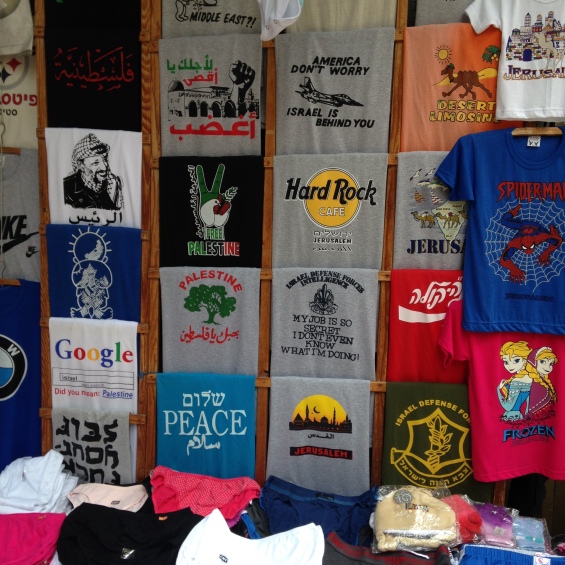
The t-shirts shocked me. Not the content of each one, but that they were displayed side-by-side. The google screenshot t-shirt that shows a search for ‘Israel’ with the response coming back, “Do you mean Palestine?” hangs alongside a t-shirt calling for peace, which is in turn next to a t-shirt with the IDF (Israeli Defence Force) logo.
(And Frozen is in there too, because, Frozen.)
I pointed out the shirts to our Israeli tour-guide. “Isn’t that so strange?” I asked him. “Wouldn’t you expect those shirts to be sold at separate shops?”
At first he was dismissive: “The owner’s a merchant – he’ll sell whatever sells.” But then he paused. “You know,” he said, “all the time I’m here, I’ve never noticed this before.” He shrugged. “Maybe it is strange. But it’s how it is here.”
This post, too, will have a little of this perspective and a little of that perspective. But no Frozen. Surely that we can all agree on.
—
We started our journey in Tel Aviv, a modern city on the Mediterranean coast, and enjoyed an absolutely perfect day there. The sun was out, and it felt like everywhere we walked (and we walked all over) something interesting was happening. Plus, I got to share a delicious breakfast with my old camp friend & former university roommate, Dania, who I totally forgot to photograph.


The next day we drove to Akko, an ancient city that was once a crusader capital. I’ve always loved Akko – and in particular the baklava in the Arab shuk there. We ate a fantastic meal at a NY Times recommended restaurant, made all that much better by the local population of semi-feral cats that kept our kids entertained while we dined.



On the way back from Akko we stopped in Netanya, a seaside city not far from Tel Aviv, to see old family friends of the Rosses.
(How old? Much to the girls’ amusement, they refer to Jordan as “Jordy,” having known him since he was about Avi’s age.)
We lit the candle for the first night of Hanukkah and ate homemade sufganiot, or donuts, an Israeli Hanukkah tradition. It was pretty awesome to be in Israel during Hanukkah after so many years in the deep diaspora (Victoria: that’s you); I initiated a game called punch-buggy Hanukkiah in which we’d hit one another each time we spotted a Hanukah menorah, but it got a little out of hand – they were everywhere, always.
Hanukkah montage:
The next morning we left our Tel Aviv digs and drove south and into the desert. Jordan’s got a thing for the desert, and it definitely was a change of landscape for our kids. We lit the candles for the 2nd night of Hanukah with an old colleague and his family on Kibbutz Keturah, then headed across the road to the Kibbutz Lotan guesthouse. Jordan and I have both spent some time living on kibbutzim, collective farms that have, for the most part, privatized in the last few decades. When I was 18 I spent a year milking cows in the Negev desert; I didn’t know it then, but it wasn’t unreasonable training for a future midwife.
Travellers tip: Kibbutzim make excellent family bases as they tend to be chock-full of eclectic playgrounds and communal green spaces, and Lotan, which teaches permaculture and natural building, was no exception.
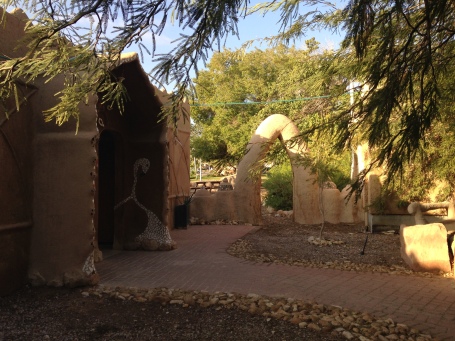

Kibbutz playgrounds are the best:
Lotan was just about 35 minutes north of Eilat, and the next morning the girls and Jordan went snorkeling while Avi and I frolicked on the beach. Afterwards, we scrambled up red-sand hills and explored ancient Egyptian mines at Timna National Park.
The hills behind Eva are in Saudi Arabia; behind Avi, the Egyptian border:

After another relaxing night on Kibbutz Lotan, we headed north to Jerusalem via the Dead Sea & Masada. Although it was a bit too windy for swimming, we walked on salt spits over pale green water at Ein Bokek.
That’s salt we’re sitting on, not sand:
We planned to stop at Masada- the desert-mountain where King Herod built his palace and which became, a century later, the hideout of the last Jewish resistance against Roman occupation. When Roman conquest became inevitable, the zealots committed mass suicide rather than risk slavery.
When we reached the mountain it had begun to rain, so we kept driving. But since then I’ve read Ari Shavit’s My Promised Land: The Triumph and the Tragedy of Israel, which gives an account of how the story of Masada, forgotten for centuries, became part of the Israeli national psyche. When I was 18, we camped in the desert and woke at dawn to climb the mountain, as countless youth groups have done before & since. At the time, I didn’t question the wisdom of celebrating a story of mass suicide in the modern-day Middle East. But Shavit makes a convincing case for the destructive mentality of the Masada story. If you’re interested in Israel- read the book. It’s excellent.
By the time we approached Jerusalem it was raining hard. We drove slowly through the neighbourhood that Jordan had lived in when he was 10, a year abroad that he cherished and that absolutely inspired our current year. The neighbourhood became “black hat” decades ago – Jerusalem is now 1/3rd ultra-orthodox, and it took miles of driving before we saw anyone who wasn’t Hasidic. For Jordan it was difficult to feel so estranged from a place so special to his own childhood.
Eventually we found our airbnb in trendy Baka – just a few blocks away from the roach-infested apartment that Jordan and I had lived in 18 years before, in our first year of living together. In Baka it felt good to be back.
The next morning we took a private tour of the Old City: we walked along the ramparts, through the Armenian, Muslim, and Jewish Quarters, and along the Via Dolorosa; touched the Western Wall and took in the crazy chaotic beauty of The Church of the Holy Sepulchre; gazed at the Mount of Olives and the throngs jostling through the Arab shuk.
And at those t-shirts, of course.
Plus another half-dozen mangy cats.
Google tells me that the entire Old City is 0.9 square kilometres; within that small space is crammed so much magnificence and so much contention. Our family of five was not a great match for the career-army guide leading us through the throngs, and he is most likely to be remembered for Eva’s whispered exclamation, “he has a gun down his pants and no underwear on!” (To be filed under: you know you’re not in Canada when.)

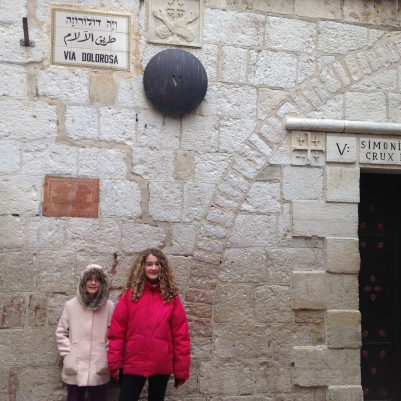
The next day I thought we’d take it easy: a slower walk through the Old City in the morning (we were on the hunt for a tallis, or prayer shawl, for Eva for her Bat Mitzvah) and a museum in the afternoon.
The morning part worked beautifully:
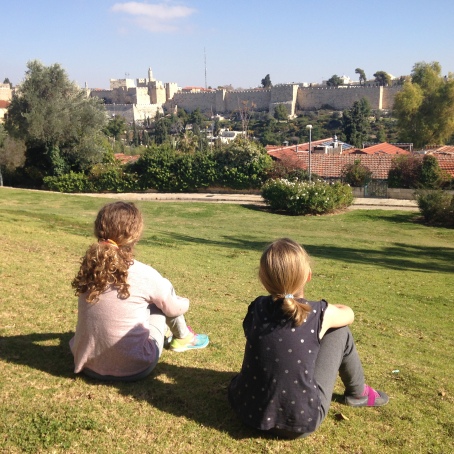
But the museum we spent the afternoon at was Yad Vashem, which is the Holocaust memorial museum. And it’s not just a museum – it’s a campus. And it’s beautiful and painful and exhausting and intense. There are memorials to lost communities and memorials for uprisings; sculptures commemorating partisans and an actual train boxcar used for transport to Auschwitz; hundreds and hundreds of trees- each bearing the name of a ‘righteous gentile’ who risked his or her own life to save a Jew, and thousands of material objects related to the Holocaust.
Perhaps the most painful memorial of all is the Children’s Memorial. Of the six million Jews murdered during the holocaust, 1.5 million were children. To put that in context: 1.5 million is more than 25% of all Canadian children.
The memorial is indoors. When you walk in, you first see just a few photographs of children who died. Already, your heart is broken:
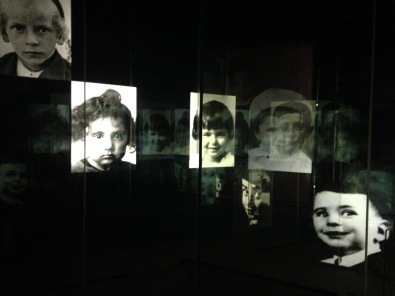
There is just one more room. It is very dark. Somewhere, a few candles are lit, and hundreds of mirrors magnify those flames so that everywhere there are flames, hundreds of thousands of flames. And as you stand there looking at them, a voice recites the name, age, and country of every child murdered.
It is unbearable. Perhaps particularly unbearable to stand there with your own two Jewish daughters, watching them listen.

At Yad Vashem, I thought about how our trip to Israel wasn’t just travel- we were actively asking the girls to engage in multiple narratives. Trendy Tel Aviv…the eco-activist Kibbutz…the ancient history & modern drama of the Old City…the tragedy of Yad Vashem.
As it happened, the next day we had one more narrative in store.
Early the next morning, we were picked up outside our rental by Green Olive Tours, a collectively-owned Israeli-Palestinian tour agency. The driver drove us into the West Bank and to the outskirts of Bethlehem, where another van, this one with Palestinian plates, was waiting to take us into Jericho and Bethlehem.

We wanted to give our girls a Palestinian perspective, and knew this was something we could not provide on our own. It ended up also being a really mesmerizing day for me and Jordan. Our guide, Amro, was young and idealistic. “Tear down all the walls, open all the borders,” he told us. “In one month, you will have peace.” At the same time, he patiently answered all our questions, many of which involved our attempts to make sense of the minutiae of occupation: ID cards and travel permits and zones – the day to day realities of living in the Occupied Territories. Amro handled the details and the storytelling with incredible grace, engaging and educating all of us.
He took us to Jericho, which claims to be, and perhaps is, the oldest city on earth, and showed us astonishing sites I’d never even heard of before despite two years living in Israel. They included Hisham’s Palace, an 8th century desert castle; excavations of ancient Jericho, the oldest of which date back to the Bronze Age; and the haunting Monastery of the Temptation, built around the mountain cave where Jesus is thought to have fasted for 40 days and nights.
Hisham’s Palace, the ruins and the model:

The cable car with the Monastery hidden in the background:

Caves in nearby hills, and the rock that Jesus sat on:
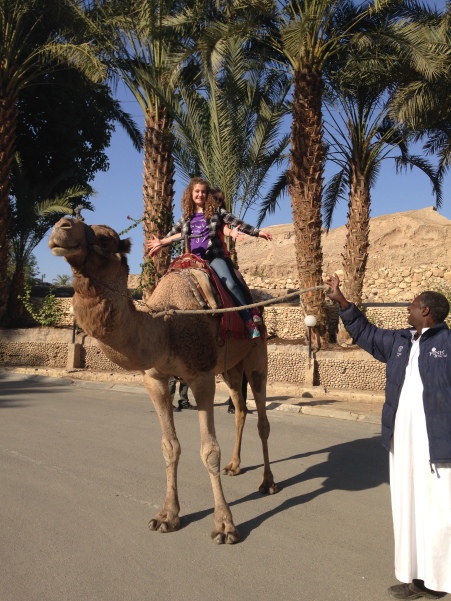
After some time ‘off’ meandering the crowded streets of downtown Jericho in desperate search of a bank machine, we went on to Bethlehem:
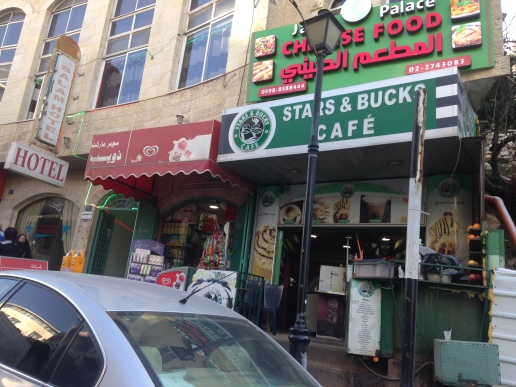
Outside of Bethlehem, we were taken to Aida refugee camp, which was established in 1950. Because the camp has been around for 66 years, it doesn’t look like a makeshift camp; there are no tents, and though the apartment buildings are crowded together the area does not look worse than many poor areas in US cities. (I know that’s not saying much. But.) Amro told us, however, that water was often scarce, and that illegal construction meant buildings would tumble in even a small earthquake.
I asked Amro why residents would remain there. For instance, I asked, if you married someone from outside the camp, wouldn’t you leave?
“You can leave,” he said, “But then you give up your refugee status.”
A key frames the entrance to the camp, symbolizing the homes the Palestinians left in 1948, when Israel was established, and the residents’ hope to return to them:
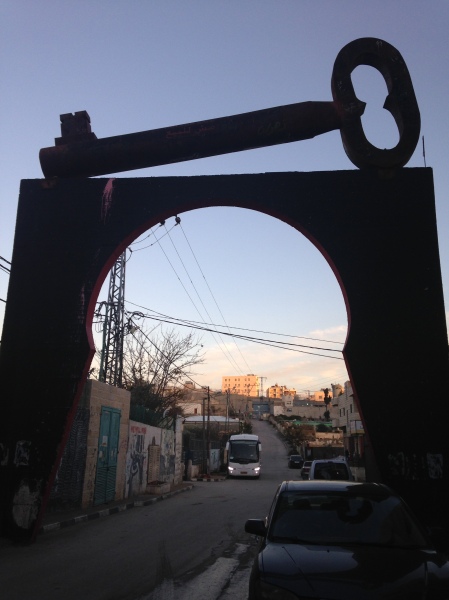

After the refugee camp we visited the separation wall. Amro, a native of Bethlehem, recounted how, as a child, he and his mother would regularly take the 8-minute bus ride into Jerusalem. The wall went up when he was 12, and for years he didn’t enter Israel. “I hated Israel,” he told us, describing how it wasn’t until he finally returned, as an 18-year-old, and met Israelis that his hate disappeared.
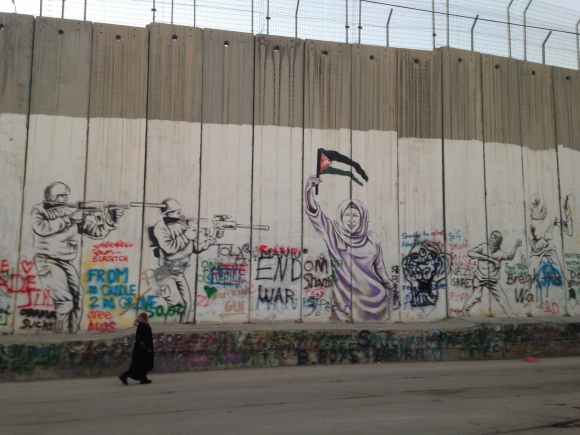


After our trip to the Palestinian Territories we had two days left in Israel: one in Jerusalem, and one in Tel Aviv. These days were just for enjoying.


Old Jaffa scenes:
One last image:

For me and Jordan it was a priority this year to bring our kids to this place where each of us has lived (both together and apart). It’s a place in which we feel both deep connection and despair. May we all live to see peace and justice in this wonderful and troubled land.




























Ilana – I’ve been reading your blog all year and have loved every second of it! It was particularly sweet to read this post about your travels in Israel/Palestine knowing that I was with you and Jordan 18 years ago. It was nice to see The Land through your eyes.
My other favorite post was “The Nun on the Train” which I initially read as “nun” as in the Hebrew letter. (Because that is my world these days.) I thought it was very funny, so much so that I read it to my dad as he was in the hospital recovering from major surgery. (He is fine.) He said that it should be published! And, it was exactly the right kind of humor at the right moment.
I look forward to reading more in the second half of the year and you all are inspiring me to dream of a similar sabbatical at some point for me and mine.
Love,
Shelley
LikeLiked by 1 person
Ohmigosh – thank you! It always feels a bit weird to write a blog post, and I so appreciate knowing that someone is listening – and enjoying them. I am especially touched to hear about you reading to your dad. I ‘follow’ you too – I’m excited and impressed by your own rabbinical journey. And yes – you were there the last time we were in Israel. I can’t believe 18 years went by…xo
LikeLike
What deep, experiential learning your kids will have gained through this trip to Israel. These are things that they would never have received through books or discussion alone. I just finished reading Jonathan Safran Foer’s new novel “Here I Am” which explores (so says the book jacket) “The question of what it is to be Jewish as well as the often complicated relationship between American Jews and Israel”. It is a big book in many ways… I loved it but was also often lost. Have you read it? I’d be interested to know if it resonated for you.
Vara
LikeLiked by 1 person
Hey Vara – I (Ilana) haven’t read it but Jordan did – I think he felt similarly, that it was excellent in parts and ungainly in others. I loved “Everything is Illuminated,” though I read it many years ago.
LikeLike